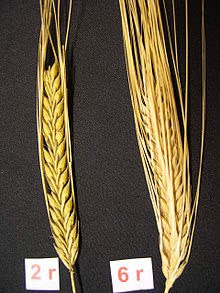
I was sitting in the shade enjoying the lovely Belgian ale on tap when someone asked me what I thought about two-row barley. I am lucky enough to live in a region where I can get either six-row or two-row most of the time, so I adjust my grain bill to the recipe at hand, rather than the other way around. Many brewers prefer two-row barley for its greater extract value; on examination that’s interesting, since the difference is 1 to 2 percent, hardly noticeable at the homebrewer level. I generally prefer two-row, but I’m not sure I could quantify why, since both types appear in many of my favorite beers. Maybe we all think two-row is just more chic.
Two-row or six-row? It’s a very American question. Most of the rest of the world uses six-row barley only for livestock feed, not for beer. I thought six-row barley had been bred especially to increase output, but it turns out to be a naturally-occurring result of a pair of mutations, one dominant and one recessive. Both two-row and six-row barley have been around for a long, long time.
Breeding efforts of the last half-century have reduced and perhaps functionally eliminated most of the differences between the two types of barley. Economies of scale at big breweries make many of their differences moot. There are still distinctions between kernel size, extract, protein and enzymes—all this information can be found online, depending on your tolerance for technical detail.
Morphology:Two-row barley kernels tend to be symmetrical and of an even size, so they tend to absorb water at about the same rate, and germinate and dry about the same; they’re also easier to grind in two-roller mills.
Six-row barley has a symmetrical center, but the two lateral rows of kernels are a little shorter, thinner, and twisted slightly. Maltsters often separate each lot of six-row barley into several kernel size fractions since they differ in water uptake and germination speed. A six-roller mill with a screening system (often used at major breweries) can make grist of the differently sized kernels. For homebrewers, a larger grist particle size dis
Malting: Scott and Cherie Stihler have a straightforward description of how a malting floor works on their site. While they acknowledge malting floors have mostly given way to big revolving drums, I agree with them that it’s easier to understand the process if you think in terms of a malting floor. Distribution is important when you’re lautering, but big breweries use a mash filter, with a filter cloth, shallower grain bed, and high pressures, so it makes almost no difference to them.
Once malted, the plumper kernels are generally re-blended and used as brewer’s malt. The thinner ones have higher enzymatic activity and may be sold as distiller’s malt. The thinnest kernels are sold as feed.
In the 1960s, a six-row cultivar called Larker significantly reduced the size difference between kernels (Larker’s name was coined from “large kernels”). Since then, new cultivars have supplanted Larker (which is no longer used as a malting barley). Plumpness in six-row barley continues to increase, but two-row varieties are still plumper. Why do we care about plumpness? Plumpness is a moderate indicator of malt extract yield, though these days six-row barley’s yield is only 1 to 2 percent lower than two-row.
Six-Row Pros:
- It has more protein, less starch, and a thicker husk than two-row.
- Higher protein levels may help speed conversion to fermentable sugars. This is important to homebrewers using high mash-in temps; more conversion would take place than otherwise.
- Six-row has higher enzyme content for converting starch into fermentable sugars. More enzymes means it can convert adjunct starches (which lack or are deficient in enzymes) during mashing. Offset this with more (less expensive) adjunct grain use, and you know why so many large breweries use six-row.
- Six-row is less expensive per pound, and allows further cost cutting through the higher use of inexpensive adjuncts to offset the high protein levels.
- Supplementing two-row malt with some six-row malt might increase extraction, conversion time, and fermentability, particularly if you have a high percentage of adjuncts.
- Six-row yields more per acre.
- Those thicker husks improve the filter bed for lautering.
Enzyme and protein levels are high enough that a brewer probably doesn’t want to use six-row barley exclusively in a recipe. (Adjunct grains are cheaper.) Unmalted cereals (corn and rice) are often mixed in with malt to compensate for the higher protein levels in six-row barley—up to 40 percent of six-row grist can be adjunct. New malt strains mean adding adjuncts is no longer necessary, but it’s economical and, in the case of some large breweries’ beers, traditional.
Six-Row Cons:
- Six row is more susceptible to the formation of dimethyl sulfide, a process begun through protein breakdown in malting. Some DMS is acceptable in some beer styles, but too much may contribute to a cooked or sweet corn flavor.
- Higher protein content can result in more break material during wort boiling and cooling, which can cause protein haze. Pay attention to this extra hot break for coagulation and removal.
- Six-row husks are high in polyphenols (tannins), which can contribute to protein-polyphenol haze, and can impart an astringent taste.
- Higher protein content often indicates less starch for conversion in malting. Six-row malting barley contains from 12-13.5 percent protein, whereas two-row has 11-13 percent. Malting doesn’t change the protein levels much.
- High protein levels can lengthen steeping time in the malting process, which causes erratic germination, particularly if low- and high-protein barleys are mixed to meet protein limits for malt. (And I was worried about controlling what went into my malt extract…)
- High proteins can lead to other beer quality issues like color control.
- Syrup adjuncts and six-row: Syrups are prepared by enzymatically hydrolyzing corn starch into fermentable sugars. It’s added to wort in fermentable form, which can take the wort over acceptable enzyme and soluble protein levels if you’re using six-row barley cultivars.

Two-Row Pros:
- Greater drought tolerance
- You can make more beer from two-row than from six-row malt; its lower enzyme content, lower protein, greater starch content, and thinner husk make it better suited to higher extract. This is less obvious at the homebrew scale and more a concern for large breweries.
- Arguably gives beer a mellower flavor than six-row.
Two-Row Cons:
- The lower diastatic (enzymatic) power of two-row becomes an issue when a large proportion of unmalted adjunct grain is used.
- Two-row tends to be more expensive per pound.
- Big breweries generally use far more adjunct grain than they strictly need; large amounts of adjuncts tend to have little body and less maltiness.
Resources
I’ve given a brief overview of the differences between two-row and six-row barley. If you’d like to learn more, here are some references I found valuable.
Brewers’ Market Guide Online’s “Special Focus: Malt.”
The Brewers’ Handbook is a great place to start.
USDA’s Cooperative Extension System Offices, or talk to your local agricultural school if you’re lucky enough to have one.
117 Pre-Prohibition Style Pils
Ingredients for 5.5 U.S. gallons (20.82 L)
Recipe provided by Misha Suggs
- 5.0 lb (2.26 kg) six-row malt
- 4.5 lb (2.04 kg) pale two-row malt
- 2.0 lb (907 g) flaked rice
- 1.0 oz (28 g) Spalt pellet hops (5% a.a.), 60 min
- 1.0 oz (28 g) Argentine Cascade pellet hops* (3.4% a.a.), 15 min
- 1.0 oz (28 g) Spalt pellet hops (5% a.a.), 5 min
- 1.0 oz (28 g) Argentine Cascade pellet hops (3.4% a.a.), 5 min
- 1 tsp Irish moss, 5 min
- WLP-800 Pilsner yeast
- Brewhouse Efficiency: 70%
- Original Gravity: 1.053
- IBUs: 32
- SRM: 3.4 (9.4 for extract version)
Directions
Perform a 30 minute protein rest at 120° F (49° C), and a 60 minute saccharification rest at 150° F (66° C). 60 minute boil. Ferment at 55° F (13° C). Follow your preferred lagering regimen.
*Note: Argentine Cascade hops are not Cascade-like. They are more similar to a cross between Hallertau and Goldings. If you can’t get them, substitute with Hallertau (or go all-out with Spalt; that’s what I’d do next time).
Extract Version: Replace pale malts with 6.5 lb (2.95 kg) Pilsner malt extract syrup and flaked rice with 21 oz (595 g) brewer’s rice syrup. Dissolve extract in water to preferred boil volume and proceed with boil.
#122 “Imperial” Pils
Ingredients for 5.5 U.S. gallons (20.82 L)
Recipe provided by Misha Suggs
- 10.0 lb (4.5 kg) Pilsner malt
- 4.0 lb (1.8 kg) six-row malt
- 3.0 lb (1.3 kg) flaked rice
- 1.0 lb (454 g) white wheat malt
- 1.0 oz (28 g) Spalt pellet hops (5% a.a.), first-wort hop
- 1.0 oz (28 g) Magnum pellet hops (10% a.a.), 45 min
- 1.0 oz (28 g) Spalt pellet hops (5% a.a.), 5 min
- 1.0 oz (28 g) Spalt pellet hops (5% a.a.), flameout
- 1.5 liter starter of WLP-840 American Pils yeast
- Brewhouse Efficiency: 70%
- Original Gravity: 1.086
- IBUs: 54
- SRM: 4.4 (13 for extract version)
Directions
Perform a 30 minute protein rest at 120° F (49° C); and a 60 minute saccharification rest at 152° F (67° C). 60 minute boil. Ferment at 55° F (13° C). Follow your preferred lagering regimen.
Extract Version: Replace pale and wheat malts with 10.5 lb (4.76 kg) Pilsner malt extract syrup and flaked rice with 34 oz (963 g) brewer’s rice syrup. Dissolve extract in water to preferred boil volume and proceed with boil.






Share Post